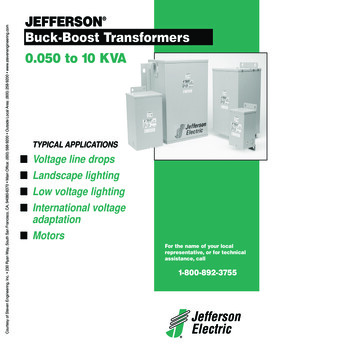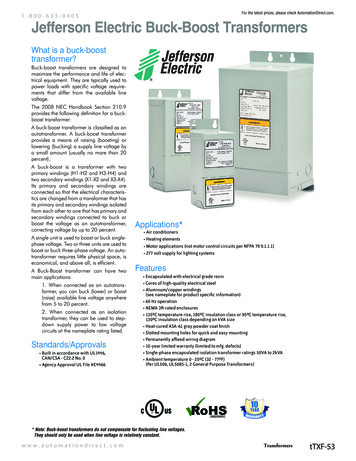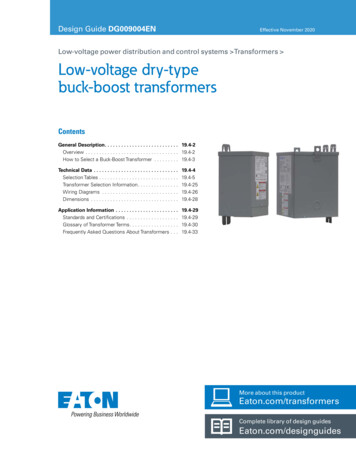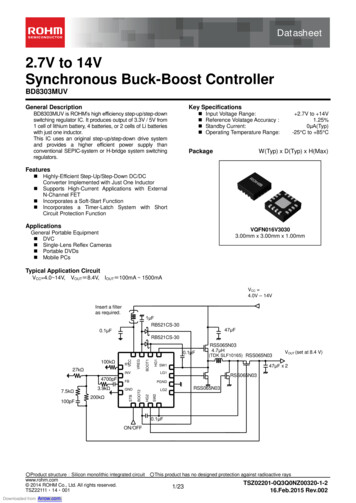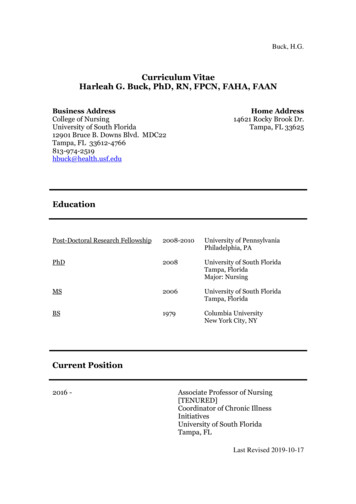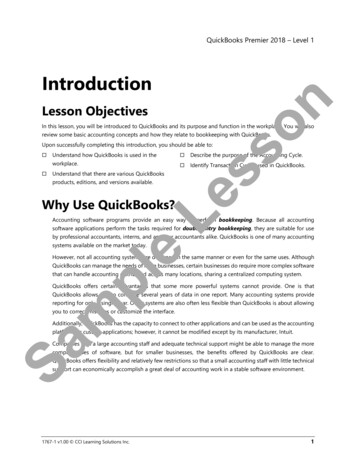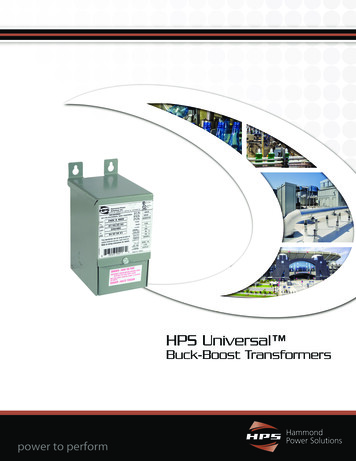
Transcription
HPS UniversalBuck-Boost TransformerWhy Use Buck-Boost Transformers?The advantages of using a buck-boost transformer over an equivalent standard isolation transformer are:Advantages1. Used in a variety of applications2. Inexpensive and stocked voltage correction3. Smaller and lighter than an isolation transformerDisadvantages1. No circuit isolation2. Cannot create a neutral3. KVA and voltages do not match what’s on the nameplate kVAand voltages.Buck-Boost ApplicationBuck-boost transformers offer an economical solution to the adjustment of line voltages that are slightly above or below normal.When a buck-boost transformer is connected as an autotransformer, only a portion of the load kVA is actually transformed. Themajority of the load kVA is passed directly through to the source. For this reason a buck-boost transformer may be used to supply amuch larger kVA load than is indicated on the nameplate.Buck-boost transformers can be used to adjust stable voltages only.STANDARD SPECIFICATIONS50 to 1000 VA1500 to 5000 VAUL Listed:File: E50394File: E50394CSA Certified:File: LR3902File: LR3902Frequency:50/60 Hz50/60 HzInsulation System:130 C (80 C rise)180 C (115 C rise)Standard Design:Single phase, welded core construction madewith high quality, high permeability siliconsteel laminations. Computer designed coils areaccurately wound from high quality coppermagnetic wire.Single phase, welded core construction madewith high quality, high permeability siliconsteel laminations. Computer designed coils areaccurately wound from high quality coppermagnetic wire.Encapsulation:All units are encapsulated with electrical gradesilica sand and resin compoundsAll units from 50VA to 5kVA are encapsulatedwith electrical grade silica sand and resincompoundsEnclosure Type:Heavy duty encapsulated type 3Roptional type 4, 4X (stainless) & 12 availableHeavy duty encapsulated type 3Roptional type 4, 4X (stainless) & 12 availableEnclosure Finish:ANSI 61 Grey, UL50ANSI 61 Grey, UL50Termination:Front accessible separate high and low voltagelead wires or copper tabsFront accessible separate high and low voltagelead wires or copper tabsConduit Knock-Outs:Side and rear standard on all units (no knockouts on Stainless Steel enclosures)Side and rear standard on all units (no knockouts on Stainless Steel enclosures)Mounting:Standard Wall MountingStandard Wall Mounting2Data subject to change without notice.
Voltage is the keyBuck-boost transformers represent an economical way to both raise supply voltage caused by line drop or equipmentdemand on the distribution system, or lower voltage caused by increased system voltages due to supply line adjustments.Some loads including lighting and resistive loads require a stable supply to maintain performance. The detrimental effects ofincorrect supply line voltage can cause equipment failure. Buck-boost transformers can correct line voltage within 5 to 25%of nominal.Steps for Selecting Buck-Boost TransformersThe following information is required before selecting a buck-boost transformer:1.Line Voltage - The voltage that you want to buck (decrease) or boost (increase). This can be determined bymeasuring the supply line voltage with a voltmeter.2.Load Voltage - The voltage at which your equipment is designed to operate. This is listed on the nameplate ofthe load equipment.3.Load kVA or Load Amps - You do not need to know both - one or the other is sufficient. This informationusually can be found on the nameplate of the equipment that you want to operate. It is the sum of all theequipment that represents the load.4.Frequency - The supply line frequency must be the same as the equipment to be operated - either 50 or 60Hertz.5.Phase - The supply line should be the same as the load - either single or three phase.HPS Universal Part Number GuideProductLineQkVAC2ExampleProduct Line:5EPrimaryQ - HPS UniversalkVA 5Primary & Secondary VoltagesP/N C05 C10 C15 C20 C25 C35 C50 C75 1C0 1C5 002 003 /N SuffixERESDTWinding Material/Electrostatic ShieldTemp. RiseKBWinding Material:C CopperK CU ShieldTemperature RiseB 80oC RiseF 115oC Rise (180oC Class)Data subject to change without notice.3
Selection ChartsSingle Phase - Group A1.2.3.4.5.From the top row of the “Selection Chart” locate the high and low voltage combination that is closest to the one you require.Move down that column to the kVA or Ampere rating equal to or greater than the rating required by the load.From the far left column, obtain the transformer catalog number.For dimensional information refer to the specifications table (Group A) on page 10.The corresponding connection diagram is indicated at the bottom of the Voltage / kVA column.120 X 240 Primary VoltsCatalog CFQ005ERCF12 X 24 Secondary 144200220208229220231220242240252240264HV AmpsKVA2.08 4.17 2.08.240 .458 2.08.550Low VoltageHigh Voltage96 100115 11050/60 HzLV Amps2.50 4.58 382.29HV Amps4.17 8.33 334.17KVA.480 .917 101.10LV Amps5.00 9.17 754.58HV Amps6.25 12.5 .56.25KVA.720 1.38 151.65LV Amps7.50 13.8 .16.88HV Amps8.33 16.7 .78.33KVA.960 1.83 202.20LV Amps10.0 18.3 .59.17HV Amps10.4 20.8 .810.4KVA1.20 2.29 252.75LV Amps12.5 22.9 .811.4HV Amps14.6 29.2 .214.6KVA1.68 3.21 353.85LV Amps17.5 32.1 .616.0HV Amps20.8 41.6 .720.8KVA2.39 4.58 .55.50LV Amps24.9 45.8 .722.9HV Amps31.2 62.5 .531.2KVA3.60 6.87 .78.25LV Amps37.5 68.7 .634.4HV Amps41.7 83.3 .341.7KVA4.80 9.17 .011.0LV Amps50.0 91.7 .545.8HV Amps62.5 2.57.20 13.7 .516.5LV Amps75.0 8.7HV Amps83.3 3.39.58 18.3 .022.0LV Amps99.8 V 4.4 27.5 .033.0137KVAKVAKVA250LV V 08KVALV Amps24.0 45.8 25.0250 458 443434CONNECTION DIAGRAM214Data subject to change without notice.2
Selection ChartsSingle Phase - Group B1.2.3.4.5.From the top row of the “Selection Chart” locate the high and low voltage combination that is closest to the one you require.Move down that column to the kVA or Ampere rating equal to or greater than the rating required by the load.From the far left column, obtain the transformer catalog number.For dimensional information refer to the specifications table (Group B) on page 10.The corresponding connection diagram is indicated at the bottom of the Voltage / kVA column.120 X 240 Primary Volts16 X 32 Secondary Volts50/60 HzCatalogNumberLow VoltageHigh 72QC05ESCBHV 1C5ESCFQ002ESCFQ003ESCFQ005ESCFLV 331.771.773.331.77HV 850.475.719.7371.47.779.8151.60.850LV 673.543.546.673.54HV .28.7131.081.102.201.171.222.401.28LV .05.315.3110.05.31HV .56.256.2512.56.25KVA.7521.431.501.56 0.871 1.630.911.70.9501.441.472.931.561.633.201.70LV .37.087.0813.37.08HV .121.191.801.843.671.952.044.002.12LV .78.858.8516.78.85HV .981.662.512.585.132.732.855.602.98LV .312.412.423.312.4HV .252.373.593.687.333.904.078.004.25LV .317.717.733.317.7HV .373.565.395.5311.05.846.1112.06.37LV .026.626.650.026.6HV .504.757.197.3714.77.798.1516.08.50LV .735.435.466.735.4HV 2.77.1210.811.022.011.712.224.012.7LV 53.110053.1HV 14.414.729.315.616.332.017.0LV 70.813370.8HV 21.622.144.023.424.448.025.5LV 06HV 56KVALV 7780.033342.51772111212124434434CONNECTION DIAGRAM5Data subject to change without notice.
Selection ChartsSingle Phase - Group C1.2.3.4.5.From the top row of the “Selection Chart” locate the high and low voltage combination that is closest to the one you require.Move down that column to the kVA or Ampere rating equal to or greater than the rating required by the load.From the far left column, obtain the transformer catalog number.For dimensional information refer to the specifications table (Group C) on page 10.The corresponding connection diagram is indicated at the bottom of the Voltage / kVA column.240 X 480 Primary Volts24 X 48 Secondary Volts50/60 HzCatalogNumberLow VoltageHigh 504QC05DTCBHV 1C5DTCFQ002DTCFQ003DTCFQ005DTCFLV 152.192.192.192.19HV .991.901.001.931.011.972.002.012.10LV 294.384.384.384.38HV .482.851.502.891.512.952.993.023.15LV 446.566.566.566.56HV .973.812.003.852.023.943.994.034.20LV 588.758.758.758.75HV .464.762.504.812.524.924.995.035.25LV 310.910.910.910.9HV 13.506.743.536.896.987.07.4LV 15.315.315.3HV 939.525.009.635.049.849.9810.110.5LV .521.921.921.921.9HV .3914.37.4914.47.5614.815.015.115.8LV .232.832.832.832.8HV 519.09.9919.310.119.720.020.121.0LV Amp
Load kVA or Load Amps - You do not need to know both - one or the other is sufficient. This information usually can be found on the nameplate of the equipment that you want to operate. It is the sum of all the equipment that represents the load. 4. Frequency - The supply line frequency must be the same as the equipment to be operated - either 50 or 60 Hertz. 5. Phase - The supply line should .
